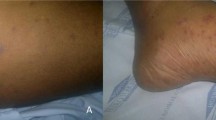Abstract
Life-threatening disseminated infection withTrichosporon beigelii (trichosporonosis) is a rare mycosis most commonly seen in patients with hematologic malignancies made neutropenic by cytotoxic therapy. This infection is usually resistant to conventional antifungal therapies. Poor correlation between therapeutic outcome of trichosporonosis and in vitro susceptibility of clinical isolates ofT. beigelii to antifungal agents is often reported. To obtain a better understanding of its pathogenesis, and to aid in the future study of the therapy of this disease, a murine model of trichosporonosis was developed. The in vitro growth of clinical isolates ofT. beigelii was first studied. Subsequently, mice made neutropenic with cyclophosphamide were inoculated intravenously with the fungus to produce the disease model. Inoculum size which produced 100% mortality, yet allowed an apparent therapeutic window (6×106) was determined. Tissue distribution and burden of organism during the course of infection was examined by viability and histopathologic studies.T. beigelii disseminated rapidly in this model, involving numerous organs including the heart, brain, kidneys, lungs, and liver. The heart and kidneys of the infected animals showed evidence of infection as early as 6 hours following inoculation. Further understanding of the pathogenesis of trichosporonosis in the neutropenic host was imparted by this study. This will aid in the future study of antibiotic treatment of this disease and its untreated progression.
Similar content being viewed by others
References
Rippon JW. Medical Mycology: The Pathogenic Fungi and the Pathogenic Actinomycetes, 3rd ed. Philadelphia: WB Saunders, 1988: 610–17.
Walsh TJ. Trichosporonosis. Infect Dis Clin North Am 1989; 3: 43–52.
Haupt HM, Merz WG, Beschorner WE, Vaughan WP, Saral R. Colonization and infection withTrichosporon species in the immunosuppressed host. J Infect Dis 1983; 147: 199–203.
Hoy J, Hsu K, Rolston K, Hopfer RL, Luna M, Bodey GP.Trichosporon beigelii infection: A review. Rev Infect Dis 1986; 8: 959–967.
Ness MJ, Markin RS, Wood RP, Shaw BW, Woods GL. DisseminatedTrichosporon beigelii infection after orthotopic liver transplantation. Am J Clin Pathol 1989; 92: 119–23.
Walling DM, McGraw DJ, Merz WG, Karp JE, Hutchins GM. Disseminated infection withTrichosporon beigelii. Rev Infect Dis 1987; 9: 1013–19.
Walsh TJ, Newman KR, Moody M, Wharton RC, Wade JC. Trichosporonosis in patients with neoplastic disease. Medicine 1986; 65: 268–79.
Watson KC, Kallichurum S. Brain abscess due toTrichosporon cutaneum. J Med Microbiol 1970; 3: 191–93.
Gold JWM, Poston W, Mertelsmann R, Lange M, Kiehn T, Edwards F, Bernard E, Christiansen K, Armstrong D. Systemic infection withTrichosporon cutaneum in a patient with acute leukemia: Report of a case. Cancer 1981; 48: 2163–67.
Jameson B, Carter RL, Watson JG, Nay RJ. An unexpected fungal infection in a patient with leukemia. J Clin Pathol 1981; 34: 267–70.
Bhansali S, Karanes C, Palutke W, Crane L, Kiel R, Ratanatharathorn V. Successful treatment of disseminatedTrichosporon beigelii (cutaneum) infection with associated splenic involvement. Cancer 1986; 58: 1630–32.
Walsh TJ, Melcher GP, Rinaldi MG, Lecciones J, McGough DA, Kelly P, Lee J, Callender D, Rubin M, Pizzo PA.Trichosporon beigelii, an emerging pathogen resistant to amphotericin B. J Clin Microbiol 1990; 28: 1616–22.
McBride ME, Kalter DC, Wolf JE. Antifungal susceptibility testing ofTrichosporon beigelii to imidazole compounds. Can J Microbiol 1988; 34: 850–54.
Melcher GP, Reed KD, Rinaldi MG, Lee JW, Pizzo PA, Walsh TJ. Demonstration of a cell wall antigen cross-reacting with cryptococcal polysaccharide in experimental disseminated trichosporonosis. J Clin Microbiol 1991; 29: 192–96.
Khan ZU, Misra VC, Randhawa HS, Damodaran VN. Pathogenicity of some ordinarily harmless yeasts for cortisone-treated mice. Sabouraudia 1980; 18: 319–27.
Lee JW, Melcher GP, Rinaldi MG, Pizzo PA, Walsh TJ. Patterns of morphologic variation among isolates ofTrichosporon beigelii. J Clin Microbiol 1990; 28: 2823–27.
Belay T, Hospenthal DR, Rogers AL, Patterson MJ. Evaluation of antibody-bearing liposomal amphotericin B in the treatment of systemic candidiasis in a neutropenic murine model. J Med Vet Mycol 1991; 29: 419–21.
Author information
Authors and Affiliations
Rights and permissions
About this article
Cite this article
Hospenthal, D., Belay, T., Lappin, P. et al. Disseminated trichosporonosis in a neutropenic murine model. Mycopathologia 122, 115–122 (1993). https://doi.org/10.1007/BF01103609
Received:
Accepted:
Issue Date:
DOI: https://doi.org/10.1007/BF01103609




